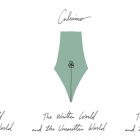Many People Die Like You by Lina Wolff

Many People Die Like You
Lina Wolff (translated from the Swedish by Saskia Vogel)
And Other Stories | August 18, 2020
In the title story of Many People Die Like You by Swedish writer Lina Wolff, now available to English readers by translator Saskia Vogel, a literature professor from Madrid is experiencing a mid-life crisis. He is unexcited by his marriage, and the affairs he hopes will break him out of his routines only bring him down further. At the story’s start, we find him sticking his hands in frozen produce just to marvel at his loss of feeling. When he seeks advice, a colleague tells him, “Your melancholy is the most human of feelings,” adding, “Many people die like you,” from “[d]eath by stifling.” The professor believes that the antidote to this living death is another affair. Unlike his wife or the students he sleeps with, this new woman’s behavior is marked by an outrageousness and extremity: she greets him swinging naked on a swing she had installed in her living room, and throws off her clothes in the middle of the Real Jardín Botánico (a botanical garden in Madrid), wades into a lily pond, and writes his name on her breasts. In the presence of such unconventionality, the professor “feels alive.” Finally, he says, he has “thawed.”
Wolff’s stories are more than quirky lessons in how to turn your life around offering a simple recipe for fighting existential dread: Be outrageous! Instead, Wolff shows us that while conventionality is, indeed, death, the opposite isn’t true: unconventionality isn’t life, and it won’t automatically make you happy—however much Wolff’s characters believe it will. Indeed, most forms of unconventionality—a topic this collection explores with avidity through absurd scenarios, irreverence, and dark humor—turn out just to be joyless attempts to run away from spiritual aridity and are just as prone to stereotype and routine as the conventional forms of existence that the characters are fleeing from. In the title story, the professor’s sense of rebirth is abruptly cut short—Wolff does not permit her protagonist to emerge triumphant. His new relationship, after all, is just another tired cliché. His new lover is a woman who fulfills his every whim, “female perfection” in his words, “tailored for him.” While her actions are extreme, they are also pathetically predictable, perfectly satisfying the most conventional of selfish male desires and fantasies. What appears as refreshingly unusual to him, is merely a further entrenchment of exactly what we expect of this character type. It is stasis: more affairs, more egotism, and more treatment of women as if they exist only to fulfill his needs.
Throughout the collection, Wolff reserves special punishment for characters who remain entrenched in typical roles, particularly those linked to their gender. In the opening story, “No Man’s Land,” a spurned housewife, chronically overcome by a sense of numbness she calls “no man’s land,” hires a detective to spy on her adulterous husband. The woman speaks about her architect husband’s latest project—a penis-shaped town fountain—and offers to show the detective a clay model of the waterworks, which features an incorporated hose through which cava is pumped in lieu of fountain water. In the final scene, the woman ties up the detective with the hose, killing him. Returning home and stumbling on the grisly scene, her husband simply says, “Darling . . . Not again.”
We realize at this point that serially murdering detectives is a form of therapy for the woman, a way to chase away the feeling of “no man’s land,” a pathology so long-standing that her husband accepts it as normal. And even though she may wield phallic maquettes as murder weapons, she is ultimately still the picture of the stereotypical spurned housewife. She continues to set the table with elaborate dinners for her husband, even when she knows he won’t be coming home. She assists him with his work and seems to revere him while paradoxically recognizing him as a monster. For her, then, the “no man’s land”—this deathly dread—is inescapable. It returns, no matter how many private detectives she murders. Seemingly unconventional, she’s in fact locked in conventionality’s grip.
While nearly all the characters in Many People Die Like You are unconventional in some way, the reasons for their outrageous behavior differ markedly. In his poem “Tintern Abbey,” Wordsworth famously casts judgment on his younger self for being “more like a man / Flying from something that he dreads, than one / Who sought the thing he loved.” This provides the distinction for the two major camps that Wolff’s outrageous characters fall into: those whose extreme behavior is motivated by fear and dread and those motivated by passion, pursuing what they love without any thought for its social acceptability.
Wolff ultimately rewards those who fall into the second group, and it is to these characters that she offers her few hopeful endings. In “Odette Klockare,” a man in his thirties is roped into giving piano lessons to an elderly recluse. Initially, he finds her repulsive—with her “old, brittle, and dry” fingers, her “shriveled” legs—but the two quickly develop a purely sexual relationship, which brings the man an unprecedented sense of happiness. The story is narrated by a collective—by a “we” made up of the other residents of his rural village. Upon catching the couple “going at it like a couple of rabbits,” the “we” demands that he confess his “shame”—something, notably, that would likely not happen if the genders in the relationship were reversed. He refuses and is appalled. His behavior, which the villagers shun as deviant, now seems to him perfectly normal. In the final scene, the man and elderly woman pack up and leave the village, seeking a more tolerant context for their happiness, an escape of that stifling milieu.
But it is not only those who eschew conventionality that are permitted by Wolff to feel the exhilaration of living honestly, and thus being spared from a living death. In “Misery Porn,” a depressed, unemployed, self-proclaimed “boring guy” jumpstarts his life by dating his neighbor and participating in her pornographic web-channel. While initially excited by the idea of a new, sexually liberated partner, her penchant for sadomasochism soon makes him feel uncomfortable. While Wolff’s story seems at first to be about the awakening of this meek, conventional man, he is able to recognize that his new, daring life just isn’t for him. The ending hints that the road to happiness for this “boring guy” may involve activities like those more conventionally associated with single men his age: a trip to Berlin with his buddy, to drink and “screw around.”
In the final two stories, there is a noticeable shift in style, as the absurd and the comic, the extreme behaviors and outrageous acts, are mostly absent and replaced with a more somber tone and elements of the supernatural. The narrator in both stories is a Swedish woman living in Madrid, just like Wolff was at the time she composed the stories. In each story, she experiences a brush with death—witnessing the angel of death in “Nuestra Señora de la Asunción,” and meeting a man who has entered into an unretractable contract to sell all of his organs in “Year of the Pig.” This man is now re-evaluating life: “He’d looked over the crowds, the young and the old, the animals and the traffic. And somewhere in all that, he’d realized everything was defective, not just him . . . he was no worse than anyone else, and he could still strive to set things right.” The story is tragic—the narrator must effectively watch a man who’s filled with a desire to live commit suicide. The narrator in “Nuestra Señora de la Asunción” is strongly affected by the vision of the angel of death and is haunted by thoughts that “nothing really matter[s]” and everything is falling apart. Yet in the final scene, she passes by a peddler who sings, “Don’t give up baby, keep the struggle baby, everything will be fine baby.”
The coda offered with these final stories presents another style of writing about conquering, or at the very least wrestling with, living death. Wolff tones down the offbeat humor: her analysis here is more mature and serious. In a collection where emotion is often refracted through the lens of irony and humor, the ending song in “Nuestra Señora de la Asunción” and the tragedy of “Year of the Pig” are rare instances of a more earnest signal of how Wolff’s characters could navigate a world in which many people are experiencing a kind of living death. It’s not necessarily a concrete lesson or a bit of parting advice, but simply another way to respond to the ubiquitous melancholy hanging over their lives, our lives. We’ve addressed death with morbid humor and oddity—flings, murders, and a DIY porn channel—and now we stave off death with morbid hopefulness, just another way Wolff gives us to respond to the inevitable.



